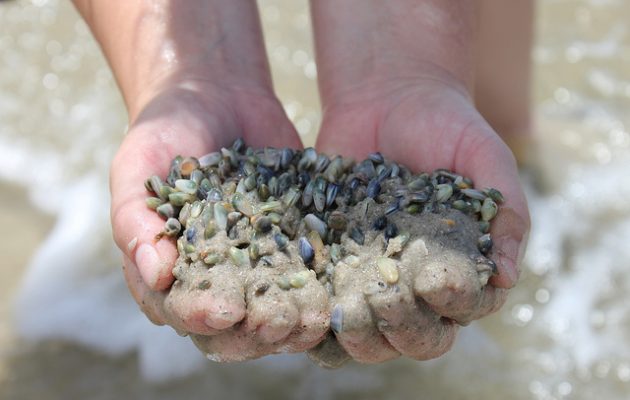Summer’s here, surf’s up: Time for a beach safari

By Jessica Basham Therriault
Florida Fish and Wildlife Conservation Commission
Not everyone has a green backyard with bushes and trees. Florida is a peninsula, with the longest coastline of all states in the continental United States. Most of Florida’s nearly 19 million residents live less than 60 miles from the Atlantic Ocean or the Gulf of Mexico, making the beach, sand and salt water their “backyards.”
So let’s go on a summer backyard beach safari!
Begin your treasure hunt by shelling. Take a walk along the water’s edge, and you’ll discover hundreds of varieties of shells hurled onto the beach by waves that roll or crash onto the shore.
Seashells were once living organisms. The shell is the hard, protective outer part of an animal, usually a mollusk. Mollusks are animals like scallops, snails, clams and oysters. These creatures make their own shell. When the animal dies or gets eaten by another creature, the empty shell stays empty or becomes a home to other sea critters like hermit crabs.
Shelling provides hours of fun while looking for that one-of-a-kind, colorful treasure. Before you keep a shell, make sure there is nothing living in it. Otherwise you need a special license to keep it.
Another activity is digging in the sand for coquinas (“Ko-KEE-nahs”) and mole crabs. It’s easy to spend hours getting lost in the color and movement of coquinas and the squirms of mole crabs. Coquinas are tiny clams that live just below the surface of the sand where the waves roll in. Tides carry and deposit them along the shoreline, where they feed on microscopic organisms in the sand. They are a dazzling sight with wonderful colors, like tiny jewels. Sometimes you don’t need to dig because incoming waves will unearth them. Watch as they furiously dig, seeking cover and food as each wave rolls back out to sea.
Mole crabs are small and do not look like a typical crab, nor do they look like a mole. They are fast and will bury themselves quickly in an effort to hide. To find one, dig gently in sand near the water, just as if you are looking for coquinas. As you dig, they may bury deeper into the sand but if you can get underneath one, then you can scoop it up. They may tickle you but don’t worry; they do not bite. Be gentle, because they are soft and fragile. When you are finished observing the crab gently place it back into the soft, wet sand.
Bird-watching is another fun activity. Gulls live on the beach and are known to swoop in to steal your food! Pesky as they might be, they are still fun to watch. Other birds to watch at the beach are pelicans. Pelicans glide just above the water’s surface, and then SPLOOSH! They dive into the water head-first to grab a fishy meal.
It’s also fun to look for bird tracks in the wet sand. Can you identify the tracks you find? Do not chase the birds to make them fly. Simply watch and admire their behavior.
While on your safari, be sure to wear sunscreen so you can avoid sunburn, and have fun this summer!






